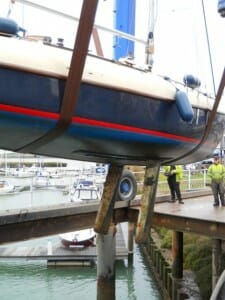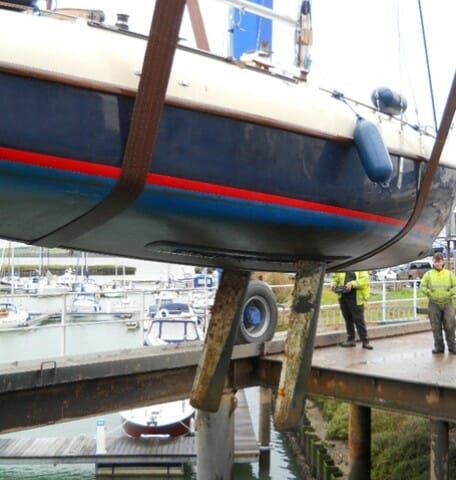
Atalanta A89 with its keels lowered fully
Sailing with variable draft
Atalanta’s can be sailed with the keels lowered or partly raised. It is usual to keep them fully down when offshore to maximise the righting moment. However they can be raised to whatever depth suites the water she is sailing in.
Just bear in mind that as you raise the keels the centre of lateral resistance will move aft, and this can lead to lee helm.
In light airs sailing with one keel fully raised can improve performance.
The keels can be treated like a dinghy’s keel, lowered to beat to windward, partly raised for reaching, and fully raised for running. You can even try raising the windward keel when beating in light winds.
Motoring
Motoring with the keels up is quite feasible. She may even go as much as a knot faster like this in calm conditions. The only disadvantage is that she will be reluctant to change course, and will tend to go sideways when you turn sharply. Just keep a few inches of one keel showing, and steering will be much improved.
Motoring with the rudder raised. The rudder is long and deep, and when fully raised will be like a barn door sticking out behind breaking the surface. Going forward the rudder will be extremely stiff, requiring firm steady pressure to move it. Going astern is tricky. Hang on to the tiller (whip staff) very firmly, and be aware that the water flow will force the helm hard over given half a chance.
Shallow water.
Sailing or motoring, is of course straight forward, assuming that the conditions will not damage the boat if you run aground. So I am thinking about sailing in rivers, creeks and the like. Hitting rocks will wreck any boat, as will beaching in a sea. You are unlikely to forget to raise the keels, and if you do you will be reminded when she slows down. If they touch the bottom, they will kick up, but will also hold the boat, anchored by the keels.
So raising the offending keel will set her free to sail on. It is a good idea to have one keel lower than the other, then you know which will have touched. Less obvious is the need to raise the rudder, which itself draws about 4 ft (1.1m) depending on type of blade. The blade does kick up on grounding, but care is needed to avoid bending the blade trying to get off.

